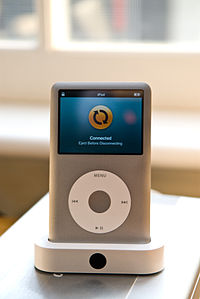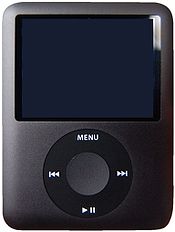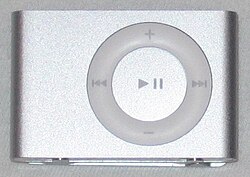| iPod touch | |
 iPod touch version 1.1.4 with January Software Upgrade. | |
| Manufacturer | Apple Inc. |
|---|---|
| Type | Portable Media Player / PDA |
| Connectivity | USB 2.0 Wi-Fi 802.11b/g |
| Retail availability | September 13, 2007-present |
| Media | Flash Memory 8, 16 & 32 GB |
| Operating system | iPhone OS (1.1.4) |
| Input | Multi-touch touchscreen |
| Power | Lithium-ion battery |
| CPU | Underclocked 620 to 412 MHz ARM |
| Memory | 128 MB |
| Display | 480 x 320 3.5" color LCD |
| Dimensions | 110×61.8×8 mm (4.3×2.4×0.31 in) |
| Weight | 120 grams (4.2 ounces) |
četrtek, 29. maj 2008
iPod touch
iPod classic
| iPod classic | |
 iPod classic in dock | |
| Manufacturer | Apple Inc. |
|---|---|
| Type | Portable media player / Digital audio player |
| Connectivity | USB 2.0 (3G, 4G, 5G, 6G) FireWire (1G, 2G, 3G, 4G) |
| Retail availability | October 23, 2001–present |
| Media | Hard disk from 5 to 160 GB (Currently 80 and 160 GB) |
| Operating system | 1.5 (1G, 2G) 2.3 (3G) 3.1.1 (4G) 1.2.1 (4G Color) 1.3 (5G) 1.1.2 (6G) |
| Input | Click wheel (4G, 5G, 6G) Scroll wheel (1G) Touch wheel (2G, 3G) |
| Power | lithium polymer battery lithium ion battery |
| Display | 160×128 2-inch monochrome LCD (1G, 2G, 3G, 4G) 220×176 2-inch color LCD (4G Color) 320×240 2.5-inch color LCD (5G, 6G) |
| Related articles | iPod shuffle iPod nano iPod touch iPhone |
iPod nano
| iPod nano | |
| | |
| Manufacturer | Apple Inc. |
|---|---|
| Type | Portable media player |
| Connectivity | Dock connector USB 2.0 FireWire (charging only) |
| Retail availability | Since September 7, 2005 |
| Media | Flash memory from 1 to 8 GB (currently 4 and 8 GB) |
| Operating system | 1.3.1 (1st Generation) 1.1.3 (2nd Generation) 1.1.2 (3rd Generation) |
| Input | Click wheel |
| Power | Lithium ion battery |
| Display | 176x132 1.5" color LCD (1G/2G) 320x240 2" color LCD (3G) |
| Predecessor | iPod mini |
iPod shuffle
| iPod shuffle | |
| Manufacturer | Apple Inc. |
|---|---|
| Type | Portable Media Player |
| Connectivity | USB 2.0 |
| Retail availability | January 11, 2005-present |
| Media | flash memory 512 MB to 2 GB currently 1 and 2 GB |
| Operating system | 1.1.5 (1G) 1.0.4 (2G), |
| Input | Volume, FF, Rev, Play/Pause Buttons |
| Power | lithium-ion battery |
| Display | None |
History and design
iPod came from Apple's "digital hub" category,[9] when the company began creating software for the growing market of personal digital devices. Digital cameras, camcorders and organizers had well-established mainstream markets, but the company found existing digital music players "big and clunky or small and useless" with user interfaces that were "unbelievably awful,"[9] so Apple decided to develop its own. As ordered by CEO Steve Jobs, Apple's hardware engineering chief Jon Rubinstein assembled a team of engineers to design the iPod, including hardware engineers Tony Fadell and Michael Dhuey,[10] and design engineer Jonathan Ive.[9] The product was developed in less than one year and unveiled on October 23, 2001. Jobs announced it as a Mac-compatible product with a 5 GB hard drive that put "1,000 songs in your pocket."
Uncharacteristically, Apple did not develop iPod's software entirely in-house, instead using PortalPlayer's reference platform based on 2 ARM cores. The platform had rudimentary software running on a commercial microkernel embedded operating system. PortalPlayer had previously been working on an IBM-branded MP3 player with Bluetooth headphones.[9] Apple contracted another company, Pixo, to help design and implement the user interface under the direct supervision of Steve Jobs.[9] As development progressed, Apple continued to refine the software's look and feel. Starting with the iPod mini, the Chicago font was replaced with Espy Sans. Later iPods switched fonts again to Podium Sans — a font similar to Apple's corporate font, Myriad. iPods with color displays then adopted some Mac OS X themes like Aqua progress bars, and brushed metal in the lock interface. In 2007, Apple modified the iPod interface again with the introduction of the sixth-generation iPod classic and third-generation iPod nano by changing the font to Helvetica and, in most cases, splitting the screen in half by displaying the menus on the left and album artwork, photos, or videos on the right (whichever was appropriate for the selected item).
iPod
Apple's proprietary iTunes software can be used to transfer music to the devices from computers using certain versions of Apple Macintosh and Microsoft Windows operating systems.[2] For users who choose not to use Apple's software or whose computers cannot run iTunes software, several open source alternatives to iTunes are also available,[3] including Amarok,[4] Banshee,[5] Rhythmbox,[6] and Songbird.[7]. As a jukebox application, iTunes stores a music library on the user's computer and can play, burn and rip music from a CD. It can also transfer photos, videos, games, contact information, E-Mail messages, Web bookmarks, and calendars to iPod models supporting those features. Apple focused its development on the iPod's unique user interface and its ease of use, rather than on technical capability. As of September 2007, the iPod had sold more than 150 million units worldwide making it the best-selling digital audio player series in history.[8]

